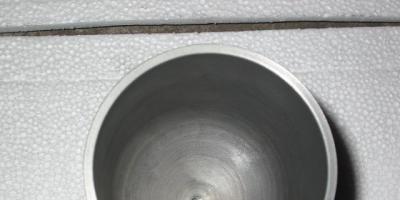Greece is the sea, olives, ancient Olympian gods, magnificent architecture and a constant atmosphere of comfort and relaxation. Greek style in the interior is a unique symbiosis of ancient and modern Greece. It combines everything we love about this country. By recreating this style at home, you will get a surprisingly comfortable home that will not leave anyone indifferent.
Characteristic features of the style
In order for the interior you created to fully correspond to the Greek style, it must meet the following characteristics:
- In the room where the style is implemented, the ceilings should be high enough.
- Columns with stucco molding are a mandatory attribute of the style. You can always use in design decorative option such columns.
- The patterns characteristic of the style are meander.
- Frescoes can be used on ceilings and walls.
- The entire color scheme is designed only in natural, restrained tones. Bright colors are completely absent. Gilding can be used as an accent, but only in a minimal amount.
- “Favorite” style materials are granite, marble and ceramic tiles.
- You also need to pay attention to ensuring that all interior details are directed vertically.
- All decorative items must be originally Greek. All kinds of amphorae, vases, sculptures and figurines are suitable for these purposes.
- Window decor is minimal. Curtains should only be used when absolutely necessary.

Floor, walls, ceiling
The peculiarity of the interior in the Greek style is the semantic emphasis on the ceiling. The special decoration of the ceiling makes the view of the visitor to the room slide from bottom to top, thereby visually making the rooms higher and airier. The modern construction market allows us to choose any ceiling design - multi-tiered, plasterboard, tension, coffered. All of them are suitable for the Greek style, the main thing is to pay attention to details. Firstly, the ceiling should be exclusively matte (no gloss). Secondly, it may contain some original image. The larger and more spacious the room, the larger the picture can be. Thirdly, the ceiling composition is crowned by a huge elegant chandelier, which hangs on chains and is framed by beautiful stucco molding.

When decorating walls, a difficult task arises. The point is that ordinary paper wallpaper will strongly contradict the Greek style, so you should abandon them and look for other finishing options. The optimal option in terms of price, complexity of work and durability is high-quality textured plaster. It should be chosen only in pastel colors. The walls can be decorated with a simple geometric or floral pattern, or a small fresco can be painted on them. If you want to draw attention to such a fresco, create a small recess for it from plasterboard in the wall. However, remember, it is very important not to overdo it with wall decor.

Ceramic tiles are best suited for the floor, however, there are no too strict rules regarding the floor. The only thing worth paying attention to in this case is that Greek style does not welcome the use of carpets on the floors. A simple meander pattern on the floor or an intricate mosaic will look very good.

Furniture selection
All furniture in the Greek style is very simple. Most often it is made from natural wood. Expensive, elaborate upholstery, such as leather or velvet, is not applicable to the Greek style. All upholstery of upholstered furniture should be simple, but good quality. Interesting feature, which is characteristic of Greek furniture, the legs of tables and chairs are always curved exclusively outward.
The living room is characterized by a low sofa in light upholstery. For the bedroom - a bed with a beautiful carved headboard and canopy. You can also add all sorts of antique wooden shelves and chests of drawers to both the living room and the bedroom. They need to be decorated with elegant forged elements.

Greek style kitchen
Greek style in the kitchen interior involves following the following rules:
- Greek cuisine will not “take root” in every apartment. Many cuisines modern houses differ in very miniature parameters. In such rooms it will not be possible to implement this style. A Greek kitchen is always very spacious, with high ceilings and large windows.
- The entire interior of such a kitchen should look as natural as possible. It is dominated by natural tones and natural materials.
- In the kitchen it is imperative to use an abundance of natural fabrics; linen is especially suitable for these purposes. Light linen curtains, tablecloths, napkins and towels will make the design very simple and stylish.
- Another mandatory requirement is that a Greek kitchen must have an abundance of living plants in pots and tubs.
- There should not be too much furniture in the kitchen. Choose only the most necessary elements. It is advisable that all furniture in the interior be made exclusively from light wood.
- Be sure to use wicker baskets to store fruits, vegetables and other things. Such baskets are a functional and stylish addition to the design.
- The finishing touch to the interior of a Greek kitchen will be a door draped in fabric with traditional Greek patterns.

A relaxing Mediterranean siesta - this is how you can describe the atmosphere that reigns in the room, decorated in Greek style. This style is quite simple and has a special charm of the southern countries.
The interior is spacious and does not tolerate pretentiousness and luxury. The main thing in the Greek style is to create a comfortable and practical living space.
Main features of the Greek style in the interior
Spacious rooms with high ceilings and large windows.
In general, the interior should look as natural as possible. Natural materials and neutral colors contribute to this.
Another characteristic feature is the abundance of accessories made from natural fabrics. These are primarily linen curtains on the windows, as well as all kinds of bedspreads and a huge amount decorative pillows.
When creating a design in the Greek style, do not forget about living plants. There should be as many of them as possible.
What colors and finishes do designers recommend choosing to decorate a room in the Greek style?
For the Greek style, designers advise using paints that are closest to natural ones. Particularly typical shades are yellow, red and sometimes green, but the main colors are considered to be white and sky blue.
They are the ones associated with the calm and harmonious atmosphere of Greece and the entire Mediterranean.
As for finishing, in this style only natural materials should be used: wood, stone, metal.
It is best to paint the walls in bright hues. It could be White color or any other neutral shade.
For finishing, you can choose textured plaster, and also decorate the walls with thematic patterns. The most typical are strict geometric designs.
Ceramic tiles are perfect for finishing the floor.
Do not forget about another characteristic feature of the Greek style - mosaics. It will fit perfectly into the overall atmosphere of the interior.
Another important point: There should not be many carpets on the floor.
The ceiling, in turn, is best left white or beige. This will highlight the antiquity of this style well.
In general, Greek-style decoration should not be intrusive. the main task- lack of pretentiousness and luxury. Housing should look stylish and cozy.
Greek style furniture is very durable and has simple shapes
Furniture is best for a Greek-style home self made, but if financial capabilities do not allow, then you can choose cheaper furniture of simple shapes.
The main rule: it must be made of natural wood.
A low, soft sofa will fit well into a Greek-style living room. It can even be somewhat rough and thereby imitate manual work. As for the upholstery, it should have light shades.
A four-poster bed with a carved headboard will fit best into a Greek-style bedroom. Also, the atmosphere will be complemented by wooden bedside tables.
Don’t forget about the various antique shelves and chests of drawers, as well as forged products, which will add a little elegance to the interior.
In the kitchen, cabinets made of light wood will look great, as well as a large, rough dinner table. You can use wicker baskets to store small items. different sizes.
In a Greek-style bathroom, smooth shapes should prevail, and in plumbing fixtures, the most appropriate color would be gold.
As for furniture, designers advise choosing small bedside tables and dressing tables.
Another interesting detail will be wicker baskets in which you can put dirty laundry.
Particular attention should be paid to mirrors. Mirrors in carved frames golden color.
Accessories and textiles in the Greek style should perform a practical function
The interesting thing is that in the Greek interior no attention is paid to accessories and textiles. special attention. If the interior contains decorative elements, then they rather perform a practical function.
Textiles are found only in the bedroom - these can be bedspreads light colors, as well as different pillow sizes. Very popular are knitted and embroidered napkins with thematic patterns that decorate chests of drawers and coffee tables.
In the kitchen, the main accessory is utensils. It usually lies on open shelves. Most Popular ceramic plates with geometric patterns, as well as flower vases of various sizes.
In a Greek-style living room you can hang several marine-themed paintings. Roman blinds would be appropriate on the windows, as well as regular curtains from linen or cotton.
It is also worth noting that the design in the Greek style suggests a large number of living plants.
To summarize, we can say that the modern Greek style is relatively inexpensive, and it is quite easy to implement it both in an apartment and in country house.
Due to its simplicity and neutral colors, the interior encourages relaxation and tranquility. And thematic decor and simple shapes furniture will always please the eye.
If you choose the Greek style, then your home will always be filled with an atmosphere of comfort, warmth and spiritual harmony.
Description of the Greek style in the interior:
The Greek (ancient Greek) interior style is characterized by a lack of luxury in the interior - the main difference from the ancient Roman style. The interior reveals the power and strength of the ancient state, which is reflected both in furniture and decoration and decorative items. Pastel colors in combination with marble -a recognizable element of style. The windows have elaborate draperies with patterns.
 In the Greek interior style, preference is given to cool colors. These are white, lemon yellow, sunny yellow, all shades of blue (from light blue to the most saturated), blue-green, blue-green, emerald colors.
In the Greek interior style, preference is given to cool colors. These are white, lemon yellow, sunny yellow, all shades of blue (from light blue to the most saturated), blue-green, blue-green, emerald colors.
Greek style walls: In the Greek interior style, bed colors are used; you can also use yellow and red tones as inserts. Greek style walls are usually plastered and can then be covered in various designs. The Greeks preferred ornaments from geometric shapes, as well as in the form of broken lines. A fresco will also look great in a Greek interior.
Greek style ceiling: Can be done in one color scheme with walls (bed, gray tones), you can also paint it with relief images of the gods of ancient Greek scenes. In any option, the ceiling is left matte, emphasizing the antiquity of the ancient Greek style.

 Greek style floor:
Small ceramic tiles, you can use a mosaic of shells or pebbles. Also in Greek design it is possible to create compositions from ceramic tiles and porcelain tiles, without deviating from the general color scheme of the Greek style.
Greek style floor:
Small ceramic tiles, you can use a mosaic of shells or pebbles. Also in Greek design it is possible to create compositions from ceramic tiles and porcelain tiles, without deviating from the general color scheme of the Greek style.
Greek style furniture: Greek furniture is simple in form. These were: benches, ordinary and ceremonial chairs, low trapezoidal dining tables on three legs in the shape of animal paws. The furniture was made of bronze, trimmed with gold, silver, upholstered, a bed with a headboard. The chairs have a simple shape, the legs are curved to the sides.
Decor items in Greek style: Huge floor and small decorative vases decorated with geometric patterns, symbolic sculptures and figurines. An integral part of the Greek-style interior is the use of columns. You can complement the Greek style by decorating the walls with laughing masks, and door handles choose in the form of an animal's head with a ring in its mouth. Greek ornamentation is characterized by both figurative and floral, as well as geometric and architectural elements.
Pro Tips:
1. - these are almost always light walls. Most often these are wooden panels painted in a certain way, as if the wind, sun and sea were testing the durability of the coating. But it is better if it is rough textured plaster, which gives the Greek interior strict simplicity and the necessary man-made charm. If you have uneven walls, then in this case, this will be a plus and will save a little time, effort and money.


2. Greek style in the interior combines various furniture. Give preference to low chairs simple tables and cabinets made of pine or stained oak in light shades. They can be decorated with either carved elements or forged or varnished iron elements. Also use ‘terrace’ furniture, with textile inserts, wicker from rattan or reeds. No upholstered furniture, especially upholstered in velvet, corduroy or leather!

3. It is desirable that the ceilings in the Greek style are high enough to create the impression of spaciousness. The surface of the ceilings should be matte and textured, while maintaining the hand-made effect.
4. When installing a Greek style floor in the interior, it is advisable to use minimal amount floor coverings. Greek style presupposes the visual integrity of the room. The most preferable tiles are unglazed tiles in warm terracotta tones. You can use imitation tiles, a decorative frieze, marble mosaic would also be appropriate.
5. Greek style in the interior uses textiles more utilitarianly than for aesthetic purposes. Fabrics are mainly of natural origin: linen, cotton, burlap. Curtains are a rarity, as historically external shutters or awnings were used. You can use blinds from natural materials(matting, bamboo, wood) or on extreme case Roman blinds made of natural fabrics.
History of the Greek style:
The Greek style in the interior is inextricably linked with the culture of this empire, history, and architecture. The culture of Ancient Greece (Hellas) began its formation 3 thousand BC e. in the form of early class societies (tribes) in the south of the Balkan Peninsula, the islands of the Aegean Sea, the coast of Thrace and the western coastline of Asia Minor. City-states began to be created only in the 8th-6th centuries. BC e. V.
formation 3 thousand BC e. in the form of early class societies (tribes) in the south of the Balkan Peninsula, the islands of the Aegean Sea, the coast of Thrace and the western coastline of Asia Minor. City-states began to be created only in the 8th-6th centuries. BC e. V.
The Greek style and its history include several periods in Greek architecture, corresponding to their time, the situation of society and culture.
Almost each of the periods is integrally associated with the famous mythological theme, where the ancient Gods were immortalized on most masterpieces of architects, sculptors and artisans. The second important aspect was the depiction of power as a sign of the strength and prosperity of the great empire, whether in the image of the torso of Hercules or the famous discus thrower by the sculptor Myron, or in the majestic columns or temples.
Ancient Greece she was not afraid to show her strength and demonstrated it in every possible way. For example, we can take gladiator fights and the Olympic Games. The Greek style constantly emphasizes this.



The earliest is the Archaic period before the time of Solomon (590 BC). Passed in relation to architecture in the development of basic principles and forms; however, no material monuments from this period have survived.
The Early Classical period (590 BC - 470 BC) can be characterized as a gradual liberation from foreign influence, the transformation of elements brought from Asia and Egypt into forms corresponding to the spirit of the people and the conditions of their religious views and rituals .
Among the temples of this era located in Greece itself, one can point out the temple of Hera in Olympia, the temple of Zeus in Athens, the temple of Apollo in Delphi (one of the most famous and luxurious sanctuaries of ancient Greece) and the temple of Pallas Athena on the island of Aegina. The Temple of Artemis in Ephesus, considered one of the wonders of the world, burned by Herostratus and rebuilt under Alexander the Great, should also be attributed to this period.




This was followed by the classical period (470 BC - 338 BC) - the most brilliant time of Greek art. In Greece itself, temples become more noble and harmonious both in their general character and in the proportionality of individual parts, and architects take care of the luxury of materials, forms and decorations.
Instead of limestone and sandstone, marble is used for buildings, which is accessible to finer processing and elegance of ornamentation. This period includes such buildings as the temple of Theseus in Athens, the temple of Nike Apteros, the temple of Demeter under the leadership, the temple of Zeus at Olympia, famous for its sculptural decorations, especially for the colossal statue of the father of the gods, executed by Phidias.
The next period of Hellenism (338 BC - 180 BC) no longer possesses the purity of taste of the previous era. Under the influence of the sensuality and delicacy of the East, which penetrated Hellas, artists are mainly concerned with the pomp and showiness of their buildings; civil buildings are being built - theaters, palaces, etc.
The transition from the previous direction to the new is expressed by the temple of Winged Athena and the temple of Zeus in Nemea. Many buildings, amazing in their luxury, appeared during this period in Asia Minor, in particular, the famous tombstone of the Carian king Mausolus (Mausoleum in Halicarnassus).
The last is the period of Roman rule. After Greece fell under the rule of Rome, architectural activity almost completely ceased in itself; but its artists, who poured into the eternal city, transferred the traditions of their native art to it and contributed greatly to the decoration of Roman architecture.
In the last period of its history, Greek architecture already merges with the history of Roman art.
Mysterious Hellas, the formidable gods of Olympus, the Argonauts, three hundred Spartans, the Golden Fleece - Ancient Greece continues to attract millions of admirers from all over the world. This eternal love is reflected in painting, applied art, fashion and cinema, and, of course, in architecture. To immerse your home in the atmosphere of antiquity and create a true “Greek style” in the interior, there are a number of rules that are practiced by the world's leading designers.
Classic features of the Greek style in the interior
Those who are new to interior styling often confuse Greek and Roman styles. But despite some similarities, they have fundamental differences. "Rome" is always characterized by pomp and luxury, and "Greece" is characterized by majestic simplicity. High ceilings, colonnade, stucco and frescoes - all this is present in the Greek style, but with the obligatory condition: color palette the main decor should be natural shades.

A pastel palette is used: boiling white, delicate olive and lemon colors, turquoise, and the entire spectrum of blue colors. Greek style is not acceptable bright colors and the abundance of gilding that is found in the Roman interior. Everything should look expensive, but elegant and discreet. Optimal materials granite, marble, natural wood, decorative rock and ceramic tiles.

It is desirable that all interior details, wall decor and even the design of furniture upholstery have a vertical orientation, creating the illusion of upward direction. This visually enlarges the room and “raises” the ceiling. An indispensable attribute of the style is a column. This architectural element is a kind of business card Greek interior. Only a colonnade can create an atmosphere of grandeur and monumentality in a room.
Also, here you will learn how to make the living room-kitchen unusual and attractive for guests. How to achieve this - read
With asceticism exterior finishing where simple plastered walls dominate, decorative items play the main stylistic role. Large floor and table vases, artificially aged mirror canvases, figurines made of bronze and marble - all of them serve as the finishing touch in the implementation of the entire design project.

How to decorate walls in Greek style
Decorating walls in such an interior is not an easy task, because not all materials are suitable for decoration. You'll have to forget about the wallpaper - you can't use it for the Greek style. Here preference is given to textured plaster followed by painting in light colors. Moreover It is not recommended to skimp on the quality of materials.

After tinting, the walls are decorated with strict floral or geometric patterns. For example, the Greek “meander” - the famous zigzag pattern, even in small volumes, can give the room the spirit of antiquity.
When decorating walls, the “fresco” technique is allowed - hand painting with special paints, usually with mythological themes. Such a picturesque panel will become a masterpiece of any living room.
How to decorate a ceiling in Greek style
The ceiling is the center of the interior composition. All architectural elements work for it, forcing the eye to slide from bottom to top, to the very heart, where a chandelier rests, framed by elegant stucco on a massive bronze chain. Ceiling design solutions can be very diverse. Multi-tiered plasterboard, suspended, tensioned and coffered - the Greek style accepts everything. The most important thing is not to overdo it with details and colors.

The fresco technique is acceptable for decorating the ceiling. And if tension structures are used, then hand painting is successfully replaced by photo printing. The stylistic image will be completed by soft matte lighting around the perimeter of the ceiling, which will highlight the relief of the ceiling plinth.
How to Create a Greek Style Floor
The flooring serves as an organic complement to the walls and ceiling. Beautiful porcelain tiles in light shades, inlaid with national ornaments, mosaic tiles, a natural stone and marble - these materials perfectly betray the spirit of antiquity. But you should give up carpets and let them be replaced by patterns on stone slabs.

How to choose Greek style furniture
The main rule of furniture is not to overload the interior with objects. Maximum air and space! The ancient Greeks did not make a cult out of furniture, however, character traits she has. Tables and chairs with legs bent to the outside, low tables on bronze “legs”, simple and high-quality upholstery of sofas - everything that is chosen should have laconic and simple forms.
Need to create unusual design bathroom? See how original and practical it can be
How to properly arrange a room for a growing child, taking into account all his preferences - read
Do you want to make your small kitchen comfortable and functional? Here you can find
The etiquette of antiquity prescribed eating while lying down, so any modern dining room furniture has a conventional Greek style. This means only good taste, moderation and professional advice will help you solve your furniture issue.
How to choose decorative elements in the Greek style
Interior accessories are very important for antique design. An indispensable attribute are ceramic or marble amphoras. You can’t do without plaster statues or at least bronze figurines. Excellent decor will be wall and floor lamps. Porcelain, bronze, decorated with antique themes or meanders - they will become bright accent interior composition.

Secrets of the masters
A beautiful element of the antique style is niche recesses in the wall. IN modern premises false - niches are created using drywall. In a house where the wall line is absolutely straight, such an idea “eats up” a share of the usable space and is optimal for very large rooms. But if the layout features give the room protrusions and corners, use them to create niches without sacrificing square meters.
Similar architectural design after finishing will look very stylish, especially if it is equipped with a delicate LED backlight and place a vase or figurine in the center.
If the Greek style is assumed at the stage of designing and building a house, plan immediately in which room the columns will be installed. For large rooms, more than four massive columns are allowed. For a small space, choose an elegant colonnade or pilasters.

Such “half-columns”, characteristic of ancient Greek architecture, are easily imitated using special polyurethane forms, which are sold in stores finishing materials. Such pilasters are glued to the wall and then covered with white matte paint. The effect of a plaster column recessed into the wall is guaranteed!

The hand-painting technique is a very expensive pleasure. Costs are reduced if premium textured photo wallpaper is used instead of a natural fresco. Their surface imitates canvas, linen or plaster. And order the plot of the drawing individually from the manufacturer. Paste photo wallpaper on the wall, decorate the “seams” with polyurethane baguette, covering it with “bronze” paint, and get a monumental painting in a stylish frame.
If a fresco is used on the walls, then painting the ceiling is not recommended. And vice versa. Greek style is distinguished by moderation and conciseness. And two bright spots in one room are clearly too much.
History of the Greek style
The ancient Greeks paid almost no attention interior decoration premises. The warm climate allowed them most time to be outside buildings. Therefore, the early period of Greek culture is associated with primitive forms of furniture and rough finishing techniques. In later periods of the development of the state, the noble part of society begins to gravitate towards luxury.

The ancient Greeks are considered the founders of coffered ceilings. The Hellenes used them in the interior of their premises as early as the 7th century BC.
Ancient Greek architects came up with a functional and decorative replacement for the column. The female statue supporting the vaults of the building is known as a caryatid. Initially, it was a symbol of the fate of the conquered Peloponnesian city of Caria, whose women fell into heavy slavery.

The famous zigzag Greek pattern owes its name to the Meander River, whose bed has intricate bends.
The marble statues of the Greek gods, which are considered white, actually had brightly colored decorative paintings. The latest research has proven the color polychrome of the surface.
The principle of the “golden ratio” is a symbol of ideal proportions in architecture and art, first described by the ancient Greek mathematician Euclid.
Bottom line
As you can see, creating an interior in the Greek style is not a lot of work. This trend has several main trends, taking into account which you can create an original and harmonious design of any room.
In order for you to fully recover when you come home and prepare yourself for everyday work, your home must not only meet your requirements for comfort, but also be in agreement with your worldview.
The Stylish Little Thing website is sure: a stylish woman should live in a stylish home. Today we will tell you how to recreate Greek style in the interior of your apartment. It is ideal for rational natures, but not alien to romance, who value simplicity, but not at the expense of aesthetics, and who strive for inner harmony.
Features of the Greek style in the interior
One of the main differences between the Greek style in the interior is naturalness. pathos and luxury are alien. Therefore, you should not confuse the Greek style with the Empire style, which owes its origin to the Roman style. The Greek style is much more democratic.
Simple geometric shapes - here is the main leitmotif of such an interior. Circles inscribed in a square are something like a trademark of the Greek style.
Finishing
In the Greek style, preference is given to pastel colors.
One of the options for wall decoration is painting with light, plain paint. Another finishing method, quite consistent with the Greek style, is plastering followed by the application of various ornaments, preferably geometric patterns. By the way, just textured plaster with an aging effect, without any patterns, will do. For lovers of natural materials, we can recommend covering the room wood panels, and then paint them according to the same concept.

Ceiling must match the floor in color and finishing material. However, for authenticity, you can put three-dimensional images from ancient Greek mythology on it.
Tile fits best into the Greek style format when it comes to floor finishing. The mosaic will look good - provided it matches the overall color scheme.
In general, thanks to the coordinated ensemble of decoration, the illusion of freedom and spaciousness in the room is created.
Color spectrum
The color scheme plays very well important role in creating an authentic interior in the Greek style. First of all, unnatural shades are not allowed in it. Everything in such a room should remind you of Mother Nature. The interior colors in the Greek style are cold. Preference is given to lemon, blue, color sea wave, emerald, etc.

As you can see, all these shades can very well be found in a real environment. Accents in the form of red and black are allowed, but accents are the ones that should still be dominant in discreet colors.
Furniture
Greek style furniture as well simple and straightforward. Low chairs, wide bed with a headboard, a rough wardrobe - this is a classic of the Greek style. The decor is dominated by light-colored wood. Handmade jewelry is in perfect harmony with general style premises, although the pieces of furniture themselves are devoid of pretentiousness.

Furniture can be decorated with carvings or forged parts, textile inserts. Rattan furniture and furniture woven from bamboo are also welcome.
And here cushioned furniture, decorated with expensive, dense fabrics, does not fit into such a situation at all.
Decor
Perhaps the specific feature that excludes the universality of the interior in the Greek style is its minimalism, some conciseness and even roughness. It’s not suitable for everyone, not everyone likes it. Another point is that in a city apartment it is difficult to recreate some authentic details of the Greek style: frescoes, columns, statues, etc. You have to limit your imagination.
However, it is quite possible to use these same attributes, so to speak, in miniature: put small figurines, lamps, amphorae in the antique style. Dishes with paintings behind glass doors are also quite in the spirit of the Greek style.

As you probably already realized, the ancient Greeks loved patterns. In addition to mosaics on the floor and paintings on the ceiling, you can use extruded designs in the form of the already mentioned geometric shapes, floral patterns, and patterns imitating sea waves.

The windows in such a room are decorated curtains made of cloth, burlap or wool. Another option is blinds made of matting or bamboo. It is quite acceptable to hang such curtains in doorways. Drapery is a bright spot that adds variety to the calm colors of the room. It can be either plain or with a pattern. But in general, the Greek-style interior is not overloaded with textiles.
A wooden lattice entwined with climbing plants- although this is, of course, a solution for summer terrace a country cottage, not a city apartment.
Door handles in the form of an animal head – special chic of the Greek style.
Greek style in the interior, despite its originality, has many fans and never loses its relevance. His important advantage is that it is quite simple to recreate it. A little imagination and creativity - and your home will be imbued with an aura of true man-made beauty and grandeur.
Stylish interior along with a website for women Stylish Thing








